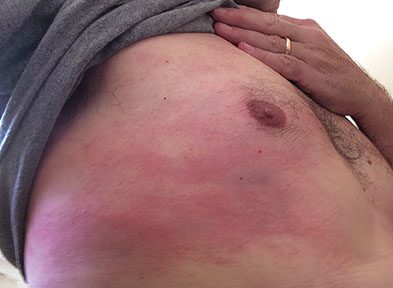I HAVE BEEN A CERTIFIED DIVER since 1986 and have logged hundreds of recreational and technical dives. Since 2014 I have primarily been doing technical rebreather diving with a close group of experienced rebreather divers from Northern California.
During the summer of 2019, our group visited Lake Huron’s Thunder Bay National Marine Sanctuary in Michigan to dive the historic shipwrecks from the late 1800s that rest nearly intact in 160 to 200 feet of icy cold and clear fresh water. Emmy-Award-winning underwater cinematographer and technical diving instructor Becky Kagan Schott and her husband, David Schott, who is also an accomplished cameraman and technical diver, organized our trip. We spent the months before the trip doing workup dives in Lake Tahoe, where water conditions are similar to Lake Huron’s.
Our Lake Huron dive plans included two dives per day, all of which entailed mandatory decompression stops because of the depth and time we spent exploring each shipwreck. As I descended the mooring line, my eyes strained for the first glimpse of what was on the bottom. I passed through the thermocline and into the clear 39°F water until I saw a narrow, dark object slowly come into view at 80 feet. It was the top of a still-upright mast. Goosebumps rose on my skin as the entirety of the wooden schooner revealed itself in nearly 100 feet of visibility. With such intact ships and artifacts, these wrecks were as close as I could get to a trip through time.

Halfway through the trip, I began to feel itchy around my chest under my drysuit during a surface interval. I instantly had a bad feeling, as this was the third time I had felt this sensation in five years. I removed my suit and saw the telltale signs of skin bends: Red, blotchy, raised bumps indicating cutaneous decompression sickness (DCS) covered part of my upper left chest. I immediately told Becky about it and started breathing 100 percent oxygen via my rebreather while lying still and resting on the boat. The itchiness and rash subsided within 30 minutes.
While talking to Becky and Dave about my situation that evening, Dave asked if I had been tested for a patent foramen ovale (PFO). His father, a cardiologist, had mentioned to Dave that repeated undeserved DCS is an indication to check for a PFO. A small hole between the two upper chambers of the heart lets blood pass from the right to the left atrium when you are in the womb, but after you are born and breathing on your own, the hole naturally fuses for most people. In about 25 percent of the population, however, the hole remains at least partially open but usually causes no ill effects. While the overall risk of DCS is low, it is higher in divers with a PFO.
I contacted DAN and sent them my computer logs, but there was nothing remarkable about my dive profiles. I have always been diligent about my hydration, and on this dive I had extended my final decompression stop beyond my already conservative decompression schedule. Thanks to DAN, I started to educate myself about PFOs, and my circumstances aligned with having one. DAN’s medical staff recommended that I have a bubble contrast test.
My primary care physician, who did not have experience with PFOs and diving, referred me to a cardiologist. Within a few weeks I had my bubble contrast study, which involved injecting a syringe of saline solution and air bubbles into an arm vein to pass through my circulation system while performing an ultrasound of my heart. I did not need to wait for my results, as I could clearly see when the bubbles passed between my atria through the PFO. I was relieved to have a potential answer to the mystery surrounding my bouts with skin bends while my fellow divers doing the same dive profiles had no such ill effects.

Photo by Keith C. Flood
After the test I was referred to an experienced cardiac surgeon specializing in PFO closures. DAN was with me each step of the way to confirm I was on the right track to make an informed decision on whether to close my PFO. I was concerned about possibly giving up diving, diving only recreationally in shallow depths, or having the elective medical procedure to close the hole in my heart.
After talking to several other divers who returned to diving after having PFO closure procedures, consulting with DAN, and weighing the pros and cons with my medical team, I opted to have my PFO closed.
The procedure is done using local anesthesia while your heart is still keeping you alive. The surgeon inserts a nickel and titanium umbrellalike closure device through a catheter from a large vein in the leg up into the heart. It can sometimes be an outpatient procedure, but mine included an overnight stay in the hospital. Six months after the closure, a follow-up bubble contrast test ensured the PFO was permanently shut, and I was cleared to return to diving.
I worked back up to how I was diving before my PFO closure, but I still pay close attention to all the best practices for technical diving. I always stay hydrated, dive conservative profiles, add some time to my final decompression stop, and never hesitate to pass on a dive if things just don’t feel right.